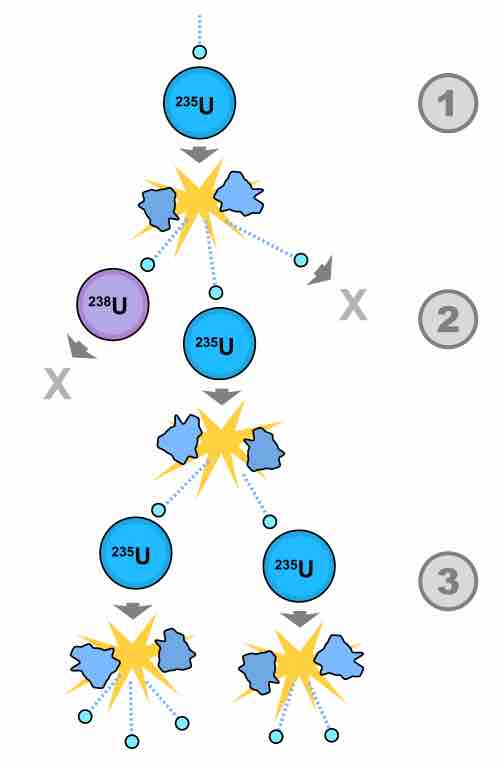Reactors and Fission
The energy released from nuclear fission can be harnessed to make electricity with a nuclear reactor. A nuclear reactor is a piece of equipment where nuclear chain reactions can be controlled and sustained. The reactors use nuclear fuel, most commonly uranium-235 and plutonium-239. The amount of free energy in nuclear fuels is far greater than the energy in a similar amount of other fuels such as gasoline. In many countries, nuclear power is seen as an environmentally friendly alternative to fossil fuels, which are non-renewable and release large amounts of greenhouse gases. However, nuclear reactors produce nuclear waste containing radioactive elements.
The Chain Reaction
When a large, fissile atomic nucleus such as uranium-235 or plutonium-239 absorbs a neutron, it may undergo nuclear fission. The nucleus splits into two or more lighter nuclei, releasing kinetic energy, gamma radiation, and free neutrons. A portion of these neutrons may later be absorbed by other fissile atoms and trigger further fission events, which release more neutrons, and so on. This is known as a nuclear chain reaction.

Nuclear chain reaction
A possible nuclear fission chain reaction. In the first step, a uranium-235 atom absorbs a neutron, and splits into two new atoms (fission fragments), releasing three new neutrons and a large amount of binding energy. In the second step, one of those neutrons is absorbed by an atom of uranium-238, and does not continue the reaction. Another neutron leaves the system without being absorbed. However, one neutron does collide with an atom of uranium-235, which then splits and releases two neutrons and more binding energy. In the third step, both of those neutrons collide with uranium-235 atoms, each of which splits and releases a few neutrons, which can then continue the reaction.
This chain reaction can be controlled using neutron poisons and neutron moderators to change the portion of neutrons that can cause more fissions. A neutron moderator works to reduce a newly produced neutron's kinetic energy from several MeV to thermal energies of less than one eV, making them more likely to induce further fission.
Nuclear reactors generally have automatic and manual systems to shut the fission reaction down if unsafe conditions are detected. The amount and nature of neutron moderation affects reactor controllability and safety. Since moderators both slow and absorb neutrons, there is an optimum amount of moderator to include in a given geometry of reactor core.
Criticality
In a nuclear reactor, the neutron population at any instant is a function of the rate of neutron production and the rate of neutron loss. When a reactor's neutron population remains steady from one generation to the next by creating as many new neutrons as are lost, the fission chain reaction is self-sustaining and the reactor's condition is referred to as "critical." When the reactor's neutron production exceeds losses, characterized by increasing power level, it is considered "supercritical." When losses dominate, it is considered "subcritical" and exhibits decreasing power.
The mere fact that an assembly is supercritical does not guarantee that it contains any free neutrons at all. At least one neutron is required to "strike" a chain reaction, and if the spontaneous fission rate is sufficiently low, it may take a long time before a chance neutron encounter starts a chain reaction—even if the reactor is supercritical. In 235U reactors, this time might be a long as many minutes. Most nuclear reactors include a "starter" neutron source that ensures a few free neutrons in the reactor core, so a chain reaction will occur immediately when the core is made critical. A common type of startup neutron source is a mixture of an alpha particle emitter such as 241Am (americium-241) with a lightweight isotope such as 9Be (beryllium-9).
Generating Electricity
Just as many conventional thermal power stations generate electricity by harnessing the thermal energy released from burning fossil fuels, nuclear power plants convert the energy released from nuclear fission. The heat is removed from the reactor core by a cooling system that generates steam. The steam drives a turbine which runs a generator to produce electricity.